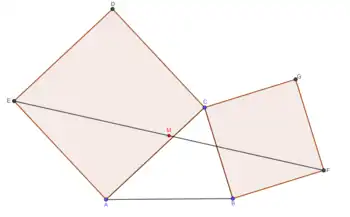
Bottema's theorem is a theorem in plane geometry by the Dutch mathematician Oene Bottema (Groningen, 1901–1992).[1]
The theorem can be stated as follows: in any given triangle , construct squares on any two adjacent sides, for example and . The midpoint of the line segment that connects the vertices of the squares opposite the common vertex, , of the two sides of the triangle is independent of the location of .[2]
The theorem is true when the squares are constructed in one of the following ways:
- Looking at the figure, starting from the lower left vertex, , follow the triangle vertices clockwise and construct the squares to the left of the sides of the triangle.
- Follow the triangle in the same way and construct the squares to the right of the sides of the triangle.
If is the projection of onto , Then .
If the squares are replaced by regular polygons of the same type, then a generalized Bottema theorem is obtained: [3]
In any given triangle construct two regular polygons on two sides and . Take the points and on the circumcircles of the polygons, which are diametrically opposed of the common vertex . Then, the midpoint of the line segment is independent of the location of .
See also
References
- ↑ Koetsier, T. (2007). "Oene Bottema (1901–1992)". In Ceccarelli, M. (ed.). Distinguished Figures in Mechanism and Machine Science. History of Mechanism and Machine Science. Vol. 1. Dordrecht: Springer. pp. 61–68. doi:10.1007/978-1-4020-6366-4_3. ISBN 978-1-4020-6365-7.
- ↑ Shriki, A. (2011), "Back to Treasure Island", The Mathematics Teacher, 104 (9): 658–664, JSTOR 20876991.
- ↑ Meskhishvili, M. (2022), "Two Regular Polygons with a Shared Vertex", Communications in Mathematics and Applications, 13 (2): 435–447